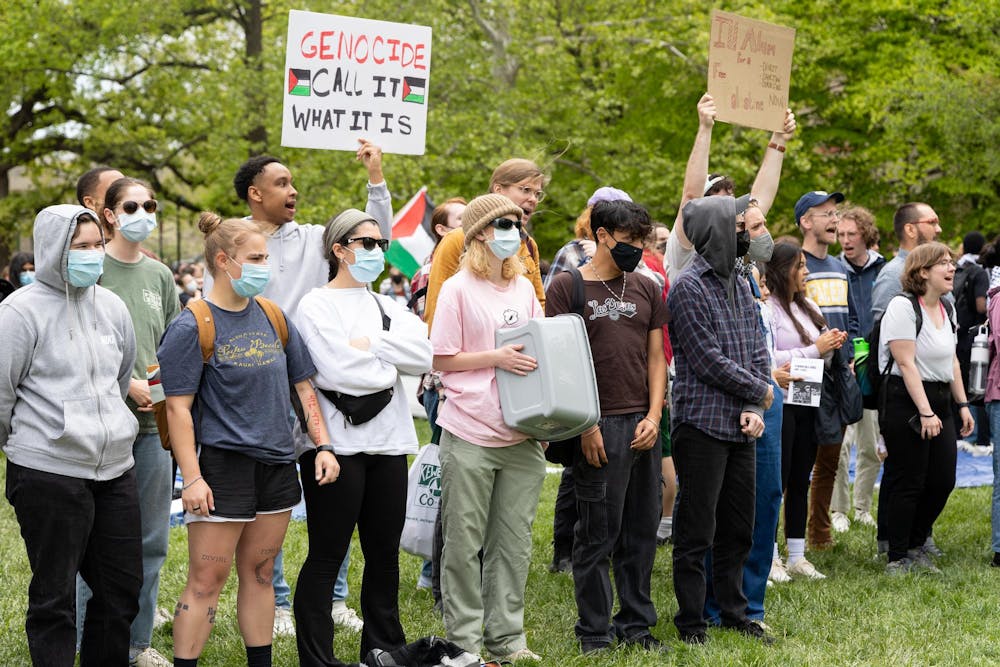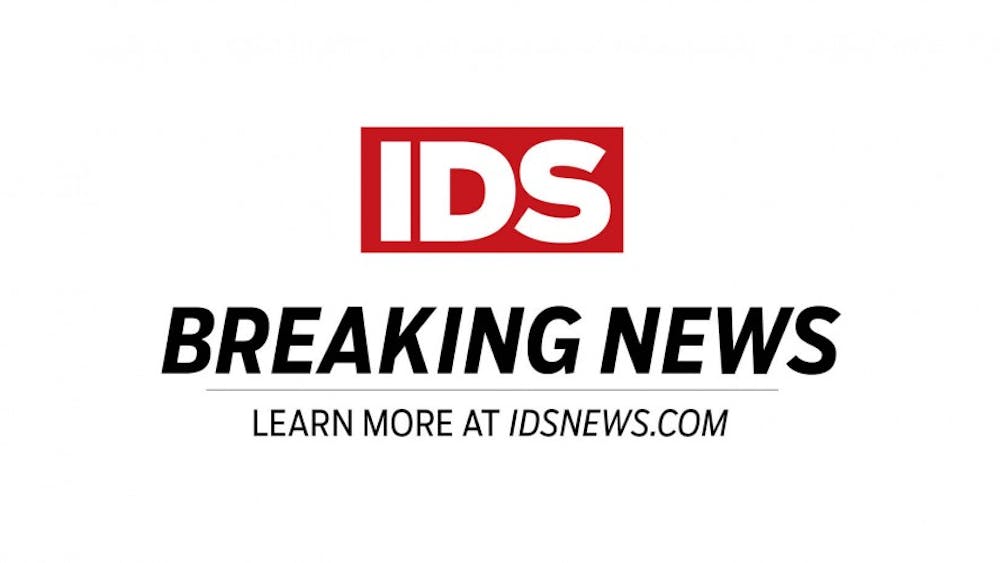In April, Indiana University summoned the Indiana State Police to Dunn Meadow to forcibly remove students and faculty violating a new outdoors space “regulation” it had “adopted” just one day earlier. The administration said a 1989 policy report provided the authority for the extraordinary process it used to adopt this regulation, which made significant changes to the rules governing the use of Dunn Meadow, IU’s venerable free speech assembly ground.
The 1989 report does no such thing. We were student government leaders during the 1980s and were involved in the process of creating the 1989 report. The preparation of that report reflects the best of the Spirit of Indiana. What happened in April does not. We write to set the record straight.
The status of Dunn Meadow as a free speech area was formalized in 1969 when the Board of Trustees designated it as the Indiana University Assembly Ground. In their resolution, the Trustees decided that at Dunn Meadow, “members of the University community may express themselves freely on all subjects, within the limits of applicable laws and regulations, with or without advance notice.” Separate policies were to govern “gatherings on campus elsewhere than on the Assembly Ground.”
Protesting in Dunn Meadow came under intense scrutiny in the mid-1980s, especially in connection with the controversial choice of the Board of Trustees to continue to invest in apartheid-era South Africa. In spring 1986, a group of about 40 students began to erect “shanties” in Dunn Meadow, meant to resemble the Bantustans in which the apartheid system forced many South African Blacks to live. Despite vandalism and threats, protesters remained in the Dunn Meadow “Shantytown” into the end of the next fall semester when its organizers voluntarily dismantled it.
These experiences prompted then-Dean of Students Michael Gordon (the first African American in a position of leadership at IUB) to empanel an Assembly Ground Advisory Committee that year to develop a set of recommendations “to guide IU in interpreting the use of Dunn Meadow as an area of protest.” We worked in and around that committee.
In 1987, the committee produced Dunn Meadow guidelines that introduced a new pre-approval requirement for the use of tents and uncarried signs in overnight Dunn Meadow protests. It became clear that the campus was not in consensus over this idea. When the Assembly Ground faced its next major protest event, the Rape Crisis Center Shanty erected in 1988, IUSA (now called IUSG) took the position that the time was not right to apply the new guidelines, and Dean of Students Michael Gordon agreed.
The Rape Crisis Shanty remained, and the Assembly Ground Advisory Committee went back to work, this time with law professor Pat Baude as chair. The committee was aided by Dr. Richard McKaig, the widely respected head of IUB’s Division of Student Affairs.
Professor Baude’s committee completed its work in the summer of 1989, with its final report presented to the Bloomington Faculty Council on October 17, 1989, assigned the number BL-ACA-I18. The Committee again recommended that leaving an uncarried sign, symbol or structure on the Assembly Ground between 11 p.m. and 6 a.m. would require advance notice and permission. Otherwise, as before, structures might be used in the Assembly Ground, day or night, to express any point of view on any subject, with or without advance notice.
The recommendation remained controversial because it impinged on a key feature that gives the Dunn Meadow Assembly Ground its unique power: the promise that members of the university community may express themselves freely there at any time on all subjects without seeking permission. In response, the Assembly Ground Committee highlighted the complexities of overnight dwelling as a form of protest and made clear that advance permission would be granted “automatically,” subject only to arrangements regarding sanitation, safety, etc. The record made clear that in deciding whether to grant a permit or not, the one thing that may never be considered is the point of view or the subject matter of the demonstration.
Fast-forward 35 years, and around April 25, 2024, an item appeared on the IU website announcing that “pursuant to ACA-BL-I18 2(C)” [sic], “the Ad Hoc Committee” had approved a new “regulation” requiring that “temporary or permanent installation of structures (including, but not limited to, signage, tents, etc.) at any time must be approved” by campus administration.
Both the express reference to “ACA-BL-I18 2(C)” in the announcement and the structure of the announcement itself make clear that the new “regulation” was grounded in the 1989 report but understanding precisely what was intended by the Administration is complicated by the fact that the webpage of the IU Office of the Vice Provost for Faculty & Academic Affairs present the 1989 report as if it were the 1969 Trustee Resolution.
On its face, the new “regulation” overturns the prior rule that students, faculty and staff may have signs and tents in Dunn Meadow any time except overnight (and even overnight, if carried) with or without permission. Moreover, because it (apparently) applies the same rule to Dunn Meadow as to all other outdoor spaces on campus, it lurches toward erasing the special status conferred on it by the Board of Trustees as the campus’s Assembly Ground.
Just hours after announcing its “regulation,” the Whitten administration called in heavily-armed Indiana State Police, including one or more roof-stationed snipers, to arrest 34 students and faculty who during the daytime April 25 had set up a small number of tents as part of a Gaza encampment, as has been allowed until the sudden change of policy. The encampment, which arises in the context of the current war in Gaza, is part of a larger protest movement that, among other things, calls for IU to divest from Israel.
As individuals who helped represent the IUB student body when the 1989 report was developed, we wish to share some thoughts about the work of the Assembly Ground Advisory Committee.
First. Many questions have been raised about the “Ad Hoc Committee” that President Whitten has said “adopted” the April 24 “regulation” pursuant to the 1989 report. Leaving aside questions like whether and how the committee was constituted over the past years, we focus on the purported authority for this process. It is true that Section 2(C) of the 1989 report suggests the creation of a committee to oversee the implementation of its provisions, to give advice on changes of policy and to review denials of permission. Ironically, this provision was added late in the process at the behest of IUSA to assure decisions taken in connection with the new policy included faculty and student input.
As both the report and the minutes of the Oct. 17, 1989, BFC meeting make clear, the committee was conceived as a standing committee that always exists, with the default membership being the IUSG president, the BFC president pro tem and a representative from the Dean of Students Office. Because vandalism and other emergency situations had arisen at prior shantytowns, it was agreed that quick decisions about encampments might sometimes be needed. The committee’s membership was kept small so that it could work fast if immediate action were needed. The inclusion of student and faculty members was designed to assure that even in “free speech” emergencies — indeed, especially in emergencies — decisions would be taken in the best spirit of shared and inclusive governance and academic freedom.
The committee President Whitten apparently made up consisted only of four administrators. Its hasty concoction on an ad hoc basis in order to “adopt” the April 24 “regulation” — and the exclusion of students and faculty from the process — are not mere procedural faults (though they are enough to dispel any notion that the regulation could have been adopted pursuant to BL-ACA-I18 2(C)). Rather, they reveal a yawning gap between the current administration and the ideals of the university as we have understood them.
Second. Section 2(D) of the 1989 report contains what we colloquially called the "no bulldozer" clause. It reflects a hard-fought compromise. Even into 1988, IUSA opposed a preapproval requirement for structures at overnight assemblies as an unacceptable breach of the promise the trustees made in 1969 to the IU community. Instead, we countered with a proposal that signs and tents left unattended for more than 72 hours could be considered abandoned and removed. In the end, IUSA accepted the overnight permission rule, but in exchange, as the report makes clear and as IUB Chancellor Kenneth R.R. Gros Louis and Chair Baude confirmed to the BFC, the “university committed itself not to use physical force” to enforce the policy but instead to adjudicate any alleged violations through an injunction proceeding in the courts.
The administration acknowledged that adjudication might make enforcement harder for the university but, they said, it was necessary to show the seriousness of IU’s commitment to free speech. Chair Pat Baude put it this way when ACA-BL-I18 was presented in October 1989: “We thought this was important because students, faculty and staff all expressed lingering doubts about the First Amendment legality of this procedure. We thought it important to insure that a court would pass upon these questions.”
Third. Timing. In order to avoid the appearance that the proposed policy changes were directed against a specific demonstration, the administration waited until October 1989 when there were no controversial demonstrations in Dunn Meadow (as there had been in the summer of 1988) before bringing up the report for consideration. This approach helps avoid liability that could arise from impermissible viewpoint discrimination by a public institution, but also belied the administration’s concern for maintaining a relationship of trust with the campus community.
Some will not recall, but the times that produced the 1989 report were fraught. The monstrousness of apartheid and the realization that IU might be helping to sustain it gnawed at the school’s soul. “But how could IU divest from Eli Lilly?” one trustee exclaimed. Passions ran high, and the choices were tough. There was intense disagreement about both aims and methods. Some years later, Chancellor Gros Louis shared how he was under considerable pressure from “inside and outside” the university to take the original Shantytown down. “There was no way that I was going to take it down!” he exclaimed.
Because of the fraught and complex nature of the issues, the Assembly Ground Advisory Committee worked slowly. Consultations were wide-ranging, exemplifying a belief that revisions to rules governing activities so much at the core of the academic enterprise and the values of the university had to be undertaken in an inclusive and deliberate fashion. We were proud to have contributed to this process. We remember well the memory of the IU leaders we worked with – Ken Gros Louis, Michael Gordon, Pat Baude – all sadly deceased, and no longer here to join us in standing up for these principles.
It took three years to produce the 1989 report. It took one night to wreck it. The new regulation was neither in fact nor spirit adopted pursuant to BL-ACA-I18.
We know because we were there.
Andrew Potts, IUSA Vice President, 1988-89
Katie Watson, Student Member, Assembly Ground Advisory Committee, 1988-89
Lisa Hanson, IUSA Treasurer, 1988-89
Caroline Moellering, IUSA Vice President, 1987-88






